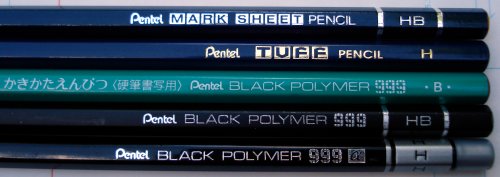
Though Pentel may be known for mechanical pencils and lead refills, their woodcase pencil products are equally outstanding.
In our lineup today, we have:
The Pentel Mark Sheet pencil is Pentel’s entry in the test scoring category. In HB, the pencil is dark blue with silver lettering. The cap is dark yellow/light orange. As a pencil, it is astounding. It sharpens easily, and writes incredibly smoothly, leaving an extremely deep, rich, saturated line – that is also erasable.
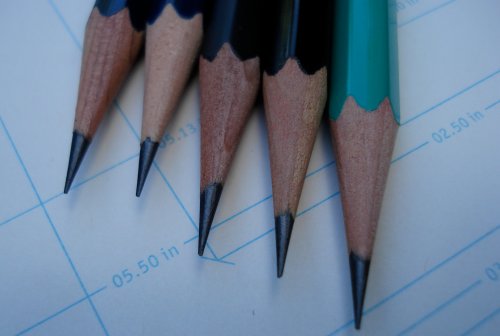
The pencil was not an entrant in last year’s test of the top Japanese pencils, but it might have been a contender. It is just amazing!
The TUFF pencil is a mystery to me. In grade H, it writes very nicely. I think it would be extremely satisfactory for someone seeking a pencil that keeps a sharp point, and writes smoothly, with a line as dark as most mainstream HB pencils.

Next, we have a turquoise version of the Pentel Black Polymer 999. The pencil has a turquoise finish and Japanese language text. Automatic translations of Pentel literature call this a “pencil for copyist” or “copyist pencil”. Perhaps someone can advise?
The space for a name on the side of the pencil suggests it is for students.
What I do know is – it is a fantastic pencil! The smooth writing qualities just amazed me. It’s nice on cream paper, but on a white paper like Clairefontaine or Rhodia, the dark rich graphite just pops! My only reservation is the turquoise colouring, which I am not sure I like.
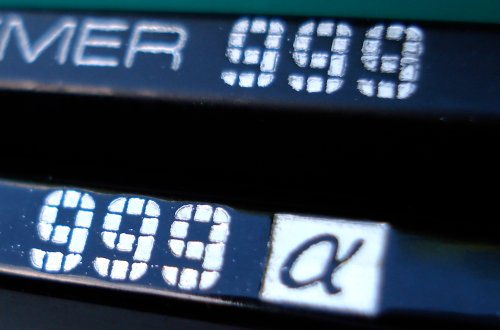
The “regular” Pentel Black Polymer 999 in HB is another well known top pencil. My growing impression is that it trades just a bit of smoothness for deep blackness, without the production of crumbles. The 4B in the series is quite amazing, creating super saturated black lines. What’s in the pencil? Is it a “polymer lead”? Stay tuned … I think we’ll learn more in the future.

The Pentel Black Polymer 999? is the top of the line. In H, it would be fine on bright white apper. I think it is quite a bit smoother than the TUFF, the other H grade pencil. It also boasts an extremely nice black lacquered finish. Though there is too much text for my taste, it is a very classy looking pencil.

We’ve heard that Pentel isn’t a woodcase pencil manufacturer per se – they subcontract their production. What can we say? Well done! The only possible criticism I can think of is that they don’t have as full a range of grades as their competitors. But everything they have done is first-rate.
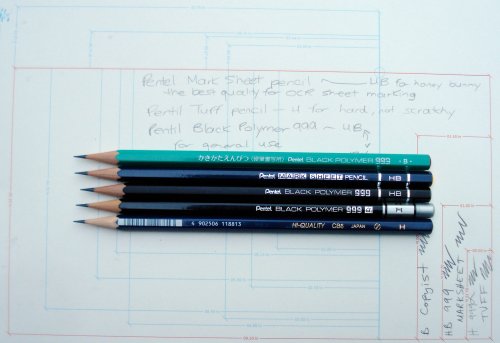
The online Pentel 2009 catalogue shows the Pentel Black Polymer 999, Pentel Black Polymer 999 Copyist, and Pentel Mark Sheet Pencils. The others may be discontinued.
| Name | Slogan | Model | Bar Code | JIS symbol |
| Mark Sheet | the best quality for OCR sheet marking | CBM10 | yes | no |
| TUFF | HI-QUALITY | CB6 | yes | yes |
| Black Polymer 999 | * | CB1 | no | no |
| Black Polymer 999 | the highest quality for general use | CB100 | yes | no |
| Black Polymer 999? | supreme quality for drawing lines of high density | CB200 | no | yes |
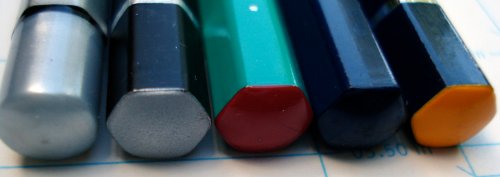
Nice pencils, Pentel!
The pencils were shown on a Mateo Ilasco No. 309 “Blueprint” notepad, and sharpened with a Carl Decade DE-100 sharpener.
My thanks to isu from the uncomfortable chair for kindly sending me the majority of these pencils.

Excellent overview of Pentel wooden pencil offerings. So far I’ve had the chance to try the Black Polymer 999 HB and the Tuff (no designation that came bundled in an Aquash crayon set). The former failed to wow me, but the Tuff was quite smooth and produced nice dark marks. Maybe I’ll try a Polymer 999 3B or 4B in the future if I can’t get my hands on Hi-Unis.
Excellent overview – thanks!
I would like to add that (as far as I know) the Hiragana lettering on the turquoise 999 – ???? ???? – means “learn to write pencil” (or something similar) which implies that it is a pencil for pupils. Besides that, I found the lettering on that pencil exceptional resistant to abrasion. A closer look gave me the impression that it isn’t printed as usual but made with some kind of lacquer. The fact that it doesn’t have a bar code or a corresponding number make that pencil even more appealing to me.
Nice review:D
The logo on the Pentel Black Polymer 999 “???????? (kakikata ennpitsu)” stands for “Pencil for writing” A solid pencil, I mean, opposes against a japanese brush. “??(shosha)” literally means copying.
I wish that could help:)
Thank you very much. I also just read the suggestion “a pencil for calligraphy”.
As well, my apologies if you have had trouble leaving a reply. The website may be having a technical issue. I am investigating.
Perhaps this isn’t the best place, but I’m sure a lot of people float across these older posts looking for information.
Anyway, according to Bundoki, the Black Polymer 999 is now discontinued. They told me they are unsure if there will be a replacement for it. I haven’t had a chance to play with it personally, but it’s always piqued my interest. It’s a real shame to see it go, especially when they haven’t announced any successors.
Of course, I could be misinformed, but if you’re a big 999 fan, you might want to stock up where you can.
Robert, thank you for the information. I have also heard that the variant with the green (turquoise?) barrel is also discontinued; to me, it’s a pity. – Those who want to stock up may look at JetPens who still have somes boxes of the black ones in stock.
It’s very regrettable if it’s true that Pentel is discontinuing the Black Polymer 999. It is/was a very decent option at a good price. Its reception is a bit two-sided, with one group thinking it rather pedestrian, and the other thinking it’s the bee’s knees. I just got a few and have to say I’m not a big fan of the fit/finish (it seems a bit cheap, partly due to the matte finish but more to the stamping/foil quality), but it’s a nice writer overall.
However, much more distressing than the loss of the pencil is the possibility that Pentel’s stepping out of the wood pencil game altogether. Combined with other discontinuations, ceasing production of the BP999 could suggest that the company is pulling away and instead only focusing on their mechanical leads (they recently released the Ain STEIN lead, though I’ve never seen it in person).
I’d also like to find out more about the polymer designation. I do suspect it’s somewhat like their mechanical pencil formulae, since the surface appearance of the lead is substantially different from any of my standard clay-ceramic pencils, and much closer in appearance to Ain and other polymer leads. My Uchida 2mm polymer leads also show this characteristic, and sharpen rather differently from my other leads. Part of me wonders if Uchida sources its leads from elsewhere…and if so, from whom. I haven’t tried asking anyone from Pentel about polymer pencil leads directly, but it would certainly be interesting to know what kind of information they could provide without a generic marketing spiel.